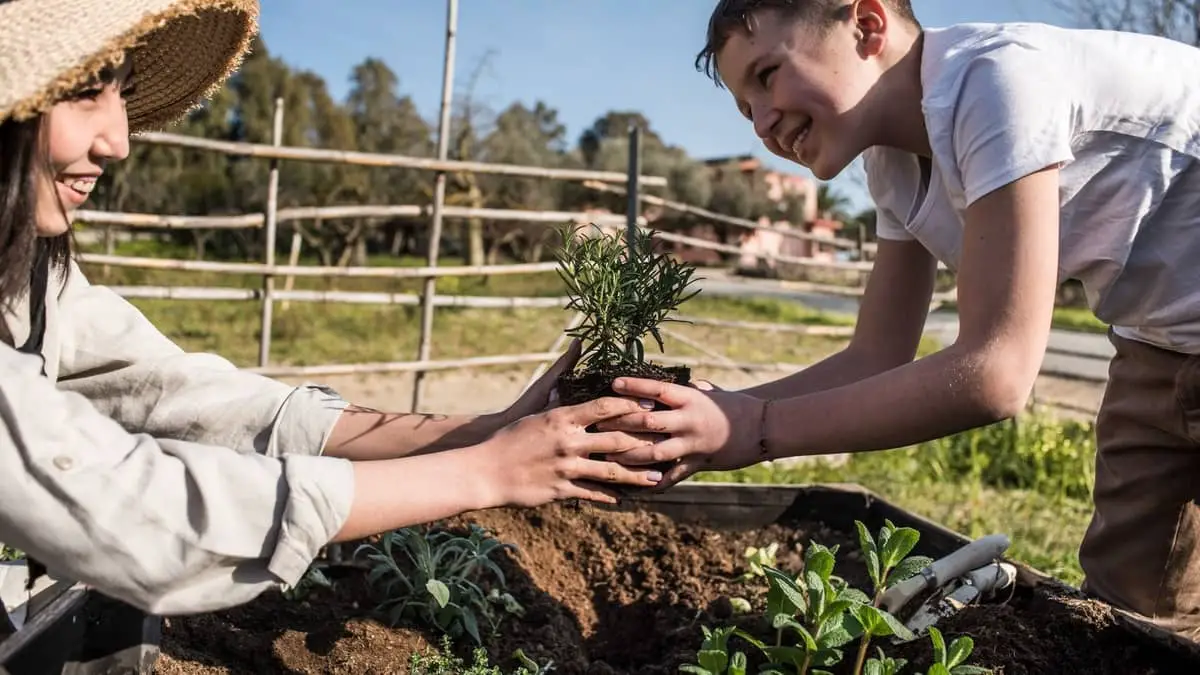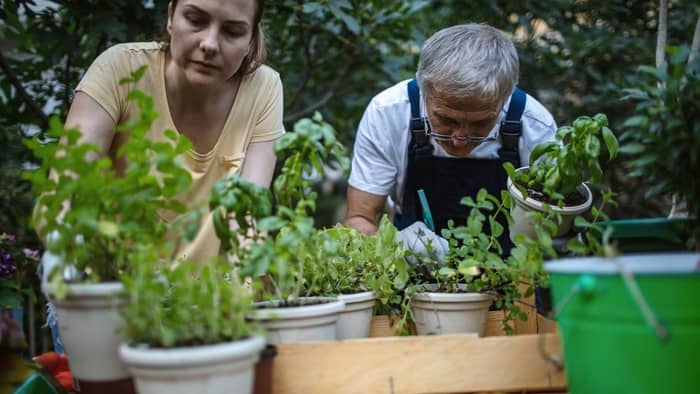Last Updated on September 3, 2022 by Griselda M.
Is growing two plants together possible? Yes. In fact, companion planting duplicates the conditions in nature in which two, or more, complimentary plants growing together will do much better than any of those plants grown on their own. Follow this article to find out a bit more about how you can use companion planting to increase the productivity of your garden.
Companion planting refers to the process by which we plant two or more plants together to ensure that they do better than if they grew on their own. To understand how to companion plant let’s first look at why we do this and a few examples of plants that allow us to harness the benefits for that reason:
Nutrients
A classic and well-known example here is the so-called three sisters’ method of planting. Maize is a heavy feeder that can deplete the soil. Beans are nitrogen-fixing plants that can improve the soil. Pumpkins and squash are rambling plants that create a living mulch over the soil and produce copious healthy squashes that can be stored for a year or more.
If we plant beans, maize, and pumpkins together, the maize grows up and depletes the soil. The beans grow their stems around the maize and use it for support. They fix nitrogen and regenerate the soil as fast as the maize depletes it.
The pumpkins ramble around under the maize and beans and cover the soil acting as a living mulch. This suppresses weeds, and the squash also mops up surplus summer water ensuring your plants do not get excess water stress.
Controlling pests
Certain plants are pest magnets – you can draw pests away from other plants towards these plants, as well as functioning to draw predator insects to the garden. In this way we can plant plants that help to maintain a healthy balance of predator insects in the garden, reducing the impact of insects that will eat our plants.
My favorite plant for this is the marigold plant. Marigolds are a bit of a weed, and I just let them go to seed, and in spring I dig seedlings up from wherever they come up and plant them near many plants. Here is the list of my favorite plants to grow with marigolds:
Potatoes
I get quite a lot of beetle and slug damage to potatoes – the marigolds appear to chase the beetles away a bit and definitely reduce the slug damage. They also help to shade the spuds a bit in summer. I don’t have any soil nematode problems, but I have heard that marigold roots infuse terpenes into the soil that can help control soil nematodes that would otherwise eat your potatoes.
Tomatoes
I find growing marigolds and tomatoes together always works well. Some people say that marigolds help deter spider mites – I am not sure about this as I have actually seen spider mites on marigolds! I do however keep a population of Persimilis predatory mites in my garden.
These mites are reported to be able to eat pollen if they cannot find spider mites to eat – my suspicion is that having the marigolds around the tomato plants is probably beneficial because it keeps a ready supply of pollen available to feed the predatory mites during times when they have eliminated spider mites. When conditions become hot and dry and spider mites explode in numbers, the predatory Persimilis mites can then emerge from the marigold flowers to start eating their favorite snacks – spider mites, keeping your tomatoes productive and healthy.
Squash/pumpkins/cucumbers
These all benefit from having marigolds dotted around. There is some evidence to suggest that marigolds produce terpenes that chase whitefly away. Again, I am a bit skeptical about this as I have seen whitefly on marigolds, but I definitely notice less of them when marigolds are around.
I think when it is windy maybe the wind blows the terpenes away, but on sunny windless days, the smell of the terpenes may build up enough to chase whitefly away. Whatever the cause, the yield of squash improves if you have marigolds around, and you also get an abundant supply of cut flowers.
Carrots and Radishes
I discovered this one by accident. A marigold came up in the middle of one of my carrot planters and the carrot planter next to it did not have a marigold. I plant a mix of carrots and cherry belle radish – the radish comes up earlier than the carrots and shades the seedlings a bit so they get established.
The marigold planter produced nearly twice as many carrots as the non-marigold planter. I am not sure why this is as my carrots get no real pests, but whatever the cause, I am not averse to having twice as many carrots so now I always plant marigold plants in each planter. I have to grow carrots in pots and planters in my area because otherwise, the mole rat eats them.
What is The First Step When Growing Two Plants Together?
There is an incredibly huge amount of toxic wisdom on the internet. I read that you “absolutely cannot” grow potatoes with onions or leaks. Well, I have grown potatoes with onions and leaks and had the best crop I have ever had.
I read that you cannot grow beans and tomatoes together – I have grown beans and tomatoes together and they did really well! It was a mess, but I could go and collect a bucket of runner beans and a bucket of tomatoes in one picking and make the most amazing supper!
I do believe that a lot of the information on the internet is based on some information somebody had – but if it is not published in a peer-reviewed journal, with proper statistics to back it up, be quite careful how much you place your faith in the advice. This applies to what I am saying too, and the great thing is, you can run a logic test on what I write, figure out if what I say makes sense or not, and then decide to follow, or discard my wisdom or lack thereof.
The logic of companion planting
When we companion plant, there is a simple basic logic we use. An ecosystem has trophic levels. What this means is that there are things that grow at different levels in a system.
Let’s take a forest – the trees that are the highest capture the sunlight, or the majority of it. They can access huge amounts of energy doing this, so they can invest in energy-intensive products such as wood that allow them to grow up and harvest this energy. Below the trees, there are other plants that are unable to harvest as much energy because the trees harvested 80 or 90% of it.
These plants have to pick up the energy crumbs. So they cannot be as big as trees – ferns, orchids and similar plants grow below the trees. These plants can, however, be clever, and produce spores, or sticky fruits that allow them to find their way up into the forest canopy, and “steal” the tree’s wood investment energy.
Other plants just grow on the forest floor and contend with the fact that they will not be very productive, and just are small, pathetic plants. However, these plants may choose to protect themselves by producing toxic chemicals – this means they could be herbs! What this means is that it is normal in nature for plants to be “planted together” and harvest energy at different “trophic levels” in an ecosystem.
iDOO 12Pods Hydroponics Growing System
A garden is an ecosystem that works for us
When we garden, we create ecosystems that work for us. Hence I often try to do “trophic level” planning when I plant companion crops. I need plants that can be sun hogs and go up and harvest most of the sunlight and do the hard work investing in how to get there.
In this case, a good example is a corn crop, a sunflower crop, or a Jerusalem artichoke crop. These plants take the time and effort to invest in heavy stalks that go far up. Beans are lazy and want to crawl around another plant that has done the work, and hence they can be companion-planted with “hard-working” plants.
Peas are the same. But peas like cooler weather, so grow peas and fava beans together. Fave beans do the hard work making long stalks, and peas abuse this for their own good and make peas.
Filling trophic levels
I often plant oregano and basilic under my perennial basil plants. The oregano and basilic benefit from the shade and protection the big basil plants provide. These creeping herbs also stop weeds from filling the lower trophic level.
One of my favorite people in the whole world is an expert in multi-trophic level aquaculture, where she works to fill in levels in aquaculture setups on a similar principle. I have learned a lot from her way of thinking and applied this to my gardening processes.
When you plant radishes and carrots together the logic is that radishes take 4-6 weeks to maturity, whereas carrots can take twice that. Hence if you plant radishes, they emerge in a few days and their leaves shade the soil and help the carrots get established. While the carrots are still trying to understand life, the radish crop is already mature and you harvest them, and then the carrots mature into the space left behind.
Take-home
By doing a bit of trophic level planning, you can plant plants that occupy different levels in an ecological niche – your garden – in such a way that you achieve greater productivity than if you just grew one plant. Companion planting makes for much more productive gardens and you can at least double the output of a garden by employing this method of growing two plants together. In conclusion, Is Growing Two Plants Together Possible? Yes, it is and it is beneficial too.
Frequently Asked Questions
Can you plant 2 plants together?
Yes. This is called companion planting. Many plants compliment each other. As an example you can plant maize and beans together. The maize is a heavy feeder, and the beans replenish the soil as they are nitrogen fixers. The maize provides a trellis for the bean to grow. The maize benefits from the nitrogen from the bean, the bean benefits from using the maize stalk to grow upwards. It is a win win situation.
Do plants grow better closer together?
This depends on light and water. If you have high light, and high water, you can plant more closely than if you have low light and high/low water. In summer, you can often crowd plants together, in winter, or fall, they need to be further apart.
What happens if you plant plants too close together?
If you plant plants too closely together they will become tall and scraggly as they try to access sunlight. They may also dry the soil out and then fall over. Over planting is generally a bad idea.
What is it called when you grow plants together?
It's called companion planting. It's a form of gardening that involves putting different types of plants together in order to encourage the growth of one another and to improve the overall health of the garden.
Caroline is a gardener who loves to get down to the nitty–gritty of gardening. She proudly proclaims herself as a ‘dirt worshipper‘ and can often be found deep in the garden, covered in soil and singing to her plants. As a self–proclaimed ‘plant whisperer‘, Caroline believes that plants need love and attention just like any other living thing, and she loves to give them both. When she‘s not tending to her garden, you can often find her researching the latest gardening trends, or teaching others how to make their gardens thrive




